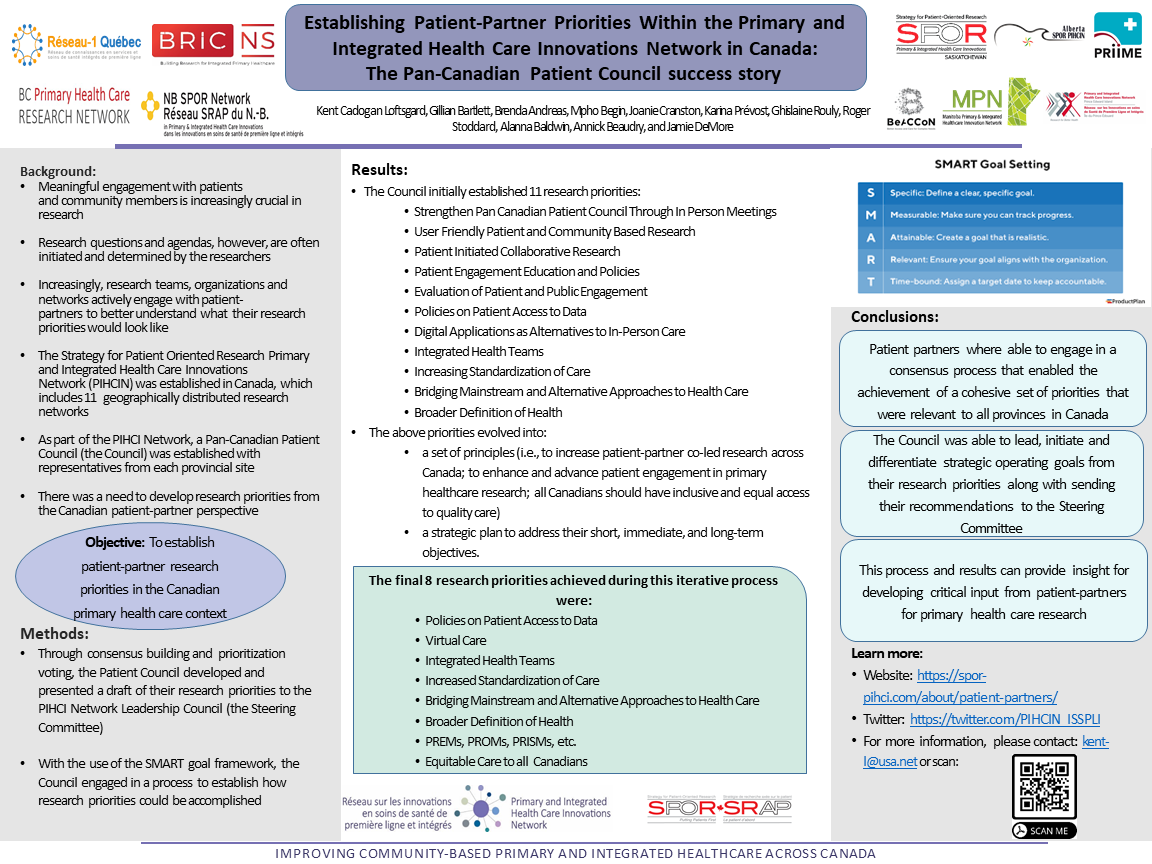PCR024: Establishing Patient-Partner Priorities Within the Primary and Integrated Health Care Innovations Network in Canada
Kent Cadogan Loftsgard; Gillian Bartlett-Esquilant, PhD; Brenda Andreas; Mpho Begin, MSc, P.Eng; Joan Cranston, BSc.P.T.; Karina Prévost; Ghislaine Rouly; Roger Stoddard; Alanna Baldwin, PhD; Annick Beaudry; Jamie DeMore, MA
Abstract
Background: Many experienced primary care researchers have seen the benefits of meaningful engagement with patients and community members in their research, elevating them to a research partner status. The research questions and agendas, however, are often initiated and determined by the researchers. Increasingly, research teams, organizations and networks actively engage with patient-partners to better understand what their research priorities would look like, bringing patient-partners into the research process much earlier. Among many other initiatives within the Strategy for Patient Oriented Research program, a Primary and Integrated Health Care Innovations Network (PIHCIN) was established in Canada, which includes 11 geographically distributed research networks. As part of PIHCIN, a Pan-Canadian Patient Council (the Council) was established with representatives from each provincial site. To ensure their voices were being heard, the Council decided to establish their own research priorities for consideration by the PIHCI network.
Objective: To establish patient-partner priorities in the Canadian primary health care context
Methods: The main goal of the Council was to submit research priorities to identify what was important from a patient-partner perspective. Through consensus building and prioritization voting, the Council developed and presented a draft of their research priorities to the PIHCI Network Leadership Council. In a second step, the Council decided that the process was missing from the document. Subsequently, with the use of the SMART goal framework, the Council engaged in a process to establish how research priorities could be accomplished.
Results: The initial research priorities comprised 11 items, including priorities concerning patient’s access to data, integrated health teams, patient initiated collaborative research, virtual care, broader definition of health, etc. The initial priorities eventually evolved into a set of principles, strategic operating goals, and finalized research priorities.
Conclusion: Through an iterative process, the Council was able to lead, initiate and differentiate strategic operating goals from the research priorities. This process and results can provide insight for developing critical input from patient-partners for primary health care research.
Objective: To establish patient-partner priorities in the Canadian primary health care context
Methods: The main goal of the Council was to submit research priorities to identify what was important from a patient-partner perspective. Through consensus building and prioritization voting, the Council developed and presented a draft of their research priorities to the PIHCI Network Leadership Council. In a second step, the Council decided that the process was missing from the document. Subsequently, with the use of the SMART goal framework, the Council engaged in a process to establish how research priorities could be accomplished.
Results: The initial research priorities comprised 11 items, including priorities concerning patient’s access to data, integrated health teams, patient initiated collaborative research, virtual care, broader definition of health, etc. The initial priorities eventually evolved into a set of principles, strategic operating goals, and finalized research priorities.
Conclusion: Through an iterative process, the Council was able to lead, initiate and differentiate strategic operating goals from the research priorities. This process and results can provide insight for developing critical input from patient-partners for primary health care research.

Jack Westfall
jwestfall@aafp.org 11/19/2021Terrific poster and presentation. Thanks for your work engaging patients and community members